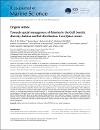Towards spatial management of fisheries in the Gulf: Benthic diversity, habitat and fish distributions from Qatari waters

عرض / فتح
التاريخ
2018المؤلف
Walton, Mark E MHayes, Jamie
Al-Ansi, Mohsin
Abdallah, Mohamed
Al Maslamani, Ibrahim
Al-Mohannadi, Mohammed
Al-Shaikh, Ismail
D’Urban Jackson, Tim
Szostek, Claire
Egerton, Jack
Kaiser, Michel J
Le Vay, Lewis
...show more authors ...show less authors
البيانات الوصفية
عرض كامل للتسجيلةالملخص
As with many other regions in the world, more complete information on the distribution of marine habitats in the Gulf is required to inform environmental policy, and spatial management of fisheries resources will require better understanding of the relationships between habitat and fish communities. Towed cameras and sediment grabs were used to investigate benthic habitats and associated epifauna, infauna and fish communities in the central Gulf, offshore from the east coast of Qatar, in water depths of between 12 and 52 m. Six different habitats were identified: (i) soft sediment habitats of mud and (ii) sand, and structured habitats of (iii) macro-algal reef, (iv) coral reef, (v) mixed reef, and (vi) oyster bed. The epibenthic community assemblage of the mud habitat was significantly different to that of sand, which in turn differed from the structured habitats of coral reef, mixed reef and oyster bed, with the macroalgal assemblage having similarities to both sand and the other structured habitats. Fish assemblages derived from video data did not differ between habitats, although certain species were only associated with particular habitats. Epibenthic diversity indices were significantly lower in mud, sand and macro-algal habitats, with no differences recorded for fish diversity. Soft sediment grab samples indicated that mud habitats had the highest benthic diversity, with Shannon-Weiner values of >4, and were more diverse than sand with values of 3.3. The study demonstrates high biodiversity in benthic habitats in the central and southwestern Gulf, which may in part be due to the absence of trawling activity in Qatari waters. There is a strong influence of depth on benthic habitat type, so that depth can be used to predict habitat distribution with a high level of accuracy. The presence of outcrops of hard substrata creates a mosaic of patchy shallow structured benthic habitat across extensive areas of the offshore seabed. Such heterogeneity, and the association of commercially exploited fish species with specific habitats, indicates that this region is well suited to a spatial approach to fisheries management.
المجموعات
- مجموعة العلوم البحرية [214 items ]

